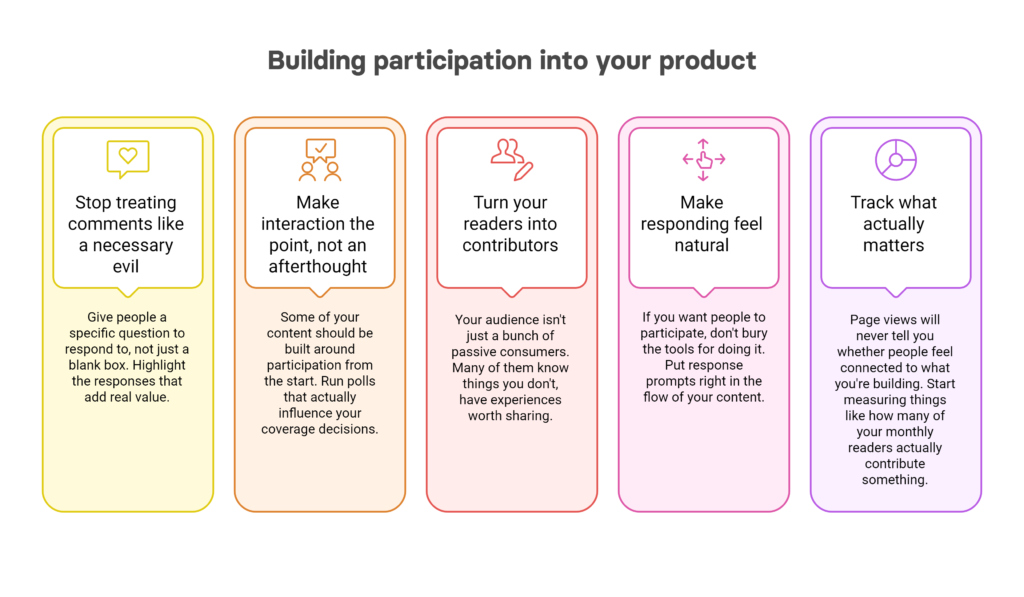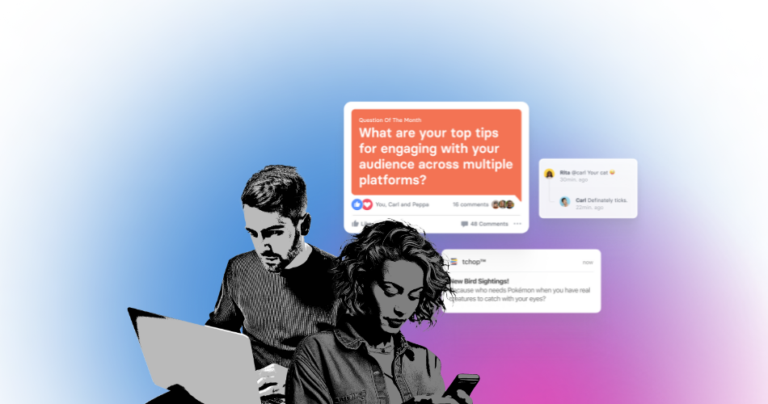Not so long ago, secret to online success was simple: publish more, publish faster. The internet rewarded volume and the numbers seemed to back it up. More posts meant more page views, more videos meant more subscribers, more content meant more everything.
But somewhere along the way, that stopped working.
Today, people don’t just want to read your article or watch your video, they want to talk back. They want to ask follow-up questions, share their own stories, maybe even challenge what you’re saying. And if they can’t do that on your platform, they’ll find one where they can.
This shift isn’t just changing how people consume media; it’s changing the entire business model. When readers become participants, they stick around longer. They come back more often. They tell their friends. Participation builds habits, habits create loyalty and loyalty turns into the kind of sustainable revenue that publishers actually need.
The challenge isn’t producing more content anymore. It’s creating the space for real conversation around that content. It’s the difference between a platform people bookmark and forget about and one that becomes part of their daily routine.

Where publishing-first models fall short
The old playbook felt foolproof: create more, get more eyeballs, grow faster. For a while, it worked well enough that nobody questioned it. Publishers hired bigger teams, cranked out more articles and watched their traffic graphs climb upward and to the right.
But then reality started creeping in.
Those page view spikes? They’d vanish the second your latest piece stopped getting shared or fell off the first page of Google. Readers would land on your site, scan your article and disappear. No follow, no bookmark, no memory of your brand five minutes later. Subscription funnels that looked promising on paper kept stalling because people weren’t actually forming habits around your content.

The whole system turned into an exhausting treadmill. You had to keep running faster just to stay in place, constantly at the mercy of whatever Facebook or Google decided to prioritize that week. One algorithm tweak could tank months of growth overnight.
Participation attacks this problem from a completely different angle. Instead of depending on the next viral hit to bring people back, you give them reasons to return that have nothing to do with your latest article. You shift the centre of gravity from getting distributed to getting people involved.
Think about what happens when someone leaves a comment that sparks a real discussion, or asks a question during your live Q&A that you actually answer, or shares a personal story that connects to your piece. They’re not just reading anymore, they’re creating a memory tied to your space. That memory is what transforms a random click into a daily habit and a daily habit into the kind of loyalty that survives algorithm changes.
This is where everything shifts: instead of obsessing over pumping out more content, you start designing experiences where readers can influence what happens after you hit publish.
How to build participation into your product
Building real participation into your product isn’t something that just happens because you want it to. You can’t slap a comment section onto your articles and call it interactive. You can’t add a “share this” button and expect people to feel involved. If you want participation to become part of how people experience your content, you have to intentionally design for it from the ground up.

Stop treating comments like a necessary evil
Most publishers approach comments the way they approach a dentist appointment. Something they know they should do but really don’t want to deal with. The comment section becomes this forgotten wasteland at the bottom of articles where trolls gather and meaningful discussion goes to die.
But comments can be one of your most powerful retention tools if you actually put effort into them. Give people a specific question to respond to, not just a blank box. Highlight the responses that add real value. Show readers that their voices matter by responding to them, featuring the best ones or even turning great comments into follow-up stories.
Make interaction the point, not an afterthought
Some of your content should be built around participation from the start. Run polls that actually influence your coverage decisions. Host live Q&As where your reporters answer questions in real time. Create stories that readers can shape through their responses, like crowd-sourced investigations or community-driven recommendations.
These formats do more than generate engagement metrics. They give people a reason to show up at a specific time, knowing their input will actually matter. That’s how you build anticipation instead of just hoping people stumble across your latest piece.
Turn your readers into contributors
Your audience isn’t just a bunch of passive consumers. Many of them know things you don’t, have experiences worth sharing or perspectives that would make your coverage better. Start treating them like the resource they are.
Feature a reader’s firsthand account alongside your reported story. Ask your community to share their expertise on topics you’re covering. Publish the niche perspectives that only your specific audience can provide. When you do this well, people don’t just read your content, they start feeling like they own a piece of it.
Make responding feel natural
If you want people to participate, don’t bury the tools for doing it. That generic “Contact us” link in your footer isn’t going to cut it. Put response prompts right in the flow of your content. Ask specific questions that people can actually answer. Make the path from reading to responding as frictionless as possible.
Track what actually matters
Page views will never tell you whether people feel connected to what you’re building. Start measuring things like how many of your monthly readers actually contribute something, what percentage of your articles generate meaningful discussion and whether people who participate stick around longer than those who just read and leave.
These are the numbers that tell you if your participation strategy is working or if you’re still just publishing into the void.

What participation looks like
The best way to understand how participation works is to see it in action. Here are publishers who stopped thinking like broadcasters and started building spaces where people don’t just show up, they stick around.
The Athletic figured out how to make sports coverage feel like hanging out
Most sports sites just pump out recaps after games end. The Athletic tried something different: live audio rooms where their beat reporters talk through what’s happening and let subscribers jump into the chat. Sometimes fans even get to actually speak.
It feels more like listening to sports radio where you can actually call in, except it’s happening online. People show up because they know they can ask questions or argue about that terrible call in the third quarter. Over one year, they ran hundreds of these things. Some had 200 people listening live and more than 2,000 fans actually got to talk.
The key thing is that when someone joins one of these rooms, they remember it. They remember the reporter who answered their question or the other fan who made that great point. That’s different from just reading an article and moving on.
Wimbledon let fans ask questions while matches were happening
This wasn’t a news site, but it’s worth looking at. Wimbledon added this AI thing called “Match Chat” where you could ask questions during matches. Like, if you wanted to know how fast that serve was or why the player was standing in a weird spot, you could just ask and get an answer right away.
It made watching tennis feel less like staring at a screen and more like having someone knowledgeable sitting next to you explaining what was going on. Instead of wondering about something and forgetting it, you could actually get answers.
Why this stuff works
Neither of these required crazy technology or huge budgets. They just understood that when people can actually do something instead of just consuming, they pay attention differently. They come back more often. They tell their friends about it.
That’s the difference between publishers who are building something people want to be part of and publishers who are just hoping people will keep showing up to read their stuff.
Why participation is the real differentiator
Don’t get me wrong, you still need good content. The articles, the videos, the reporting. That’s not going anywhere. But here’s the thing: good content isn’t special anymore. Everyone can publish now and pretty much everyone does.
What makes some platforms forgettable and others impossible to quit isn’t how much they publish, it’s how deeply people can participate.
Participation is what makes people stick. It’s what turns someone who reads your stuff occasionally into someone who pays for it and someone who pays for it into someone who can’t shut up about it to their friends. It’s the difference between being just another bookmark they never click and being the place they check first thing in the morning because something’s always happening there.
The question isn’t whether publishers should start building for participation. That ship has sailed. The only question is how fast you can make this shift before your competitors figure it out.
Publishers who keep thinking the old way, just cranking out more content, chasing page views, sweating every algorithm change; they’re going to stay stuck on that treadmill. Forever at the mercy of Google and Facebook, forever one update away from watching their traffic disappear.
But the publishers who make participation central to everything they do? They’re building something more solid: actual relationships with real people who give a damn about what happens next.
And relationships, not reach, are what’s going to matter in whatever comes after this era of media. Because relationships are the one thing platforms can’t take away from you.
Publishing wins you attention. Participation wins you loyalty. Only one of those pays the bills.










